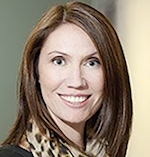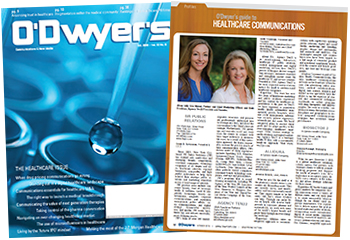 Carrie Jones Carrie Jones |
The annual J.P. Morgan Healthcare Conference—which will take place 13-16 January in San Francisco—has become a can’t-miss moment for hundreds of companies and thousands of attendees every year. The proximity of the conference to the end of most companies’ fiscal year makes it a powerful forcing function for closing out the previous 12 months and laying out expectations for the year ahead. It’s also a magnet for a huge volume of news opportunities.
Reporters and their outlets consider the conference a one-stop shop for sourcing current and future news. The majority of them take publication-wide notes to build a reservoir of stories for the year ahead, doing so during official presentations and as many in-person briefings as their schedules can accommodate. Ask any journalist at the end of the conference and they’ll tell you it feels like they just finished a marathon.
 |
| This article is featured in O'Dwyer's Oct. '19 Healthcare & Medical PR Magazine. |
Even large companies benefitting from a steady drumbeat of media coverage strategically align major deals around the meeting’s news cycle. In 2019, Lilly arranged for a surprise purchase of Loxo Oncology, grabbing scores of headlines and flummoxing industry-watchers who surmised the company might have saved millions of dollars by waiting just a few weeks. As a result of these clever maneuvers, reporters have an exceedingly high bar for breaking news at the conference.
For smaller companies—or those with longer-term news opportunities—there remain many reasons to build relationships, provide context for future news and even work their way into competitors’ stories by being in the right place at the right time.
Having supported dozens of small and mid-sized companies over the course of several J.P. Morgan conferences, we’ve learned what it takes to succeed from a corporate communications perspective. Here’s your primer for what works and what doesn’t, based on our experience driving media results.
Strategies that work
Have your materials and logistics locked in before the first pitch goes out. In order to snap up space in reporters’ schedules before the competition, you’ll need to have your spokesperson bios, availability, location, and onsite contact numbers ready to go. This will ensure that when a reporter replies with interest in an interview, you can seal the deal quickly without waiting days to reserve locations or get materials approved by legal.
Keep every communication succinct. And we mean brief. Reporters are swamped with interview requests, which means the most direct e-mails are the most useful. Our pitches are often just a couple of sentences that provide journalists with key reasons on why they should meet with a company, along with topics executives can address in current or future stories. Also, for public companies, don’t forget to include your ticker symbol.
Provide the spokesperson you offered. It makes perfect sense to split up meetings across the C-suite to lighten the load on a busy CEO. However, if a reporter has been offered a briefing with the CEO, that’s who they’ll be expecting. Changing spokespeople at the last-minute feels like a bait and switch and is harmful to the relationship with the reporter over the long term. Our advice is to align tiers or types of media with specific executives ahead of time, and then stick to this arrangement from the first pitch to the actual interview. If a journalist misses an appointment or an unforeseen circumstance arises, such as a travel delay, then it’s reasonable to offer an alternative.
When possible, have your executive in one location for interviews. Back-to-back briefings are truly a best-case scenario, but when it does happen, you’ll want to have your executive’s location locked in for the duration. If funds allow, booking a hotel suite on the same block as the conference venue is ideal, though you may need to book it a year in advance. If this isn’t possible, make sure to leave plenty of buffer time between interviews for getting to new locations.
Ask for cell numbers early. Trust me, you’ll need them. Once the meeting has started, it can be very tough to track anyone down via e-mail, especially reporters who are constantly running to their next meeting. We often get cell numbers as we are confirming the interviews. That way, when—not if—someone gets lost, is running late, or you can’t find each other, you’ll have an immediate way to get in touch.
Create surround sound with a strong social media presence. We counsel our clients to be deft in their use of social media during the conference to make sure they are visible beyond its walls, where attention spans are short. Twitter also can be an excellent way to keep track of reporters you care about to get a sense of what they’re focusing on and following during the conference.
But don’t do this
Don’t delay in following up as soon as the agenda is released. Journalists often wait on the agenda before confirming any bookings. However, the window of opportunity to lock in those meetings once the agenda comes out is very small. We recommend getting on reporters’ radars and providing availability in advance of the agenda release and then following up the day the agenda is distributed to lock it in.
Don’t ignore what reporters aren’t telling you. Successful media relations is all about balance and knowing when to say when. Push too hard, and you’ll lose a relationship for life. But don’t push hard enough, and you may just get lost in the shuffle. Avoid going around people, and make sure you’re being helpful, not annoying.
Don’t ignore the laws of physics. In regular life, a 15-minute walk is reasonable, but it’s out of the question in the fast-paced J.P Morgan conference environment, especially when your competitors have onsite meeting rooms and are willing to meet in a lobby or corridor. In this case, proximity and convenience trump all other considerations; this is no time for excessive formality. The one exception? Be sure you have a quiet space available if you’re doing a video interview.
Don’t cave to FOMO. The J.P. Morgan conference is a big opportunity, which is why so many companies experience serious fear of missing out. But it’s a huge investment of time and precious communications dollars—and it’s not the only opportunity to get noticed. We always consider whether it’s worth a full-court press around the conference, or whether the client’s story might be better told before or afterwards.
With thousands of investors, startups, industry leaders, patient advocates, media and of course, executives and their communications teams all elbow-to-elbow, the frenetic pace of these jam-packed few days at the beginning of the year offer tremendous opportunities for companies to tell their stories in a forum that can have a major impact on their bottom lines.
We’ve only just scratched the surface on what it takes to make the J.P. Morgan Healthcare Conference a communications success. There’s so much more to consider, and every situation is unique. It’s an environment where experience and relationships matter as much as a smart plan and responsive team, areas where JPA Health delivers tremendous value for its clients.
***
Carrie Jones is Principal at JPA Health.


 Lo Isidro, senior director at Real Chemistry with more than a decade of strategic communications and PA experience, has joined Narrative Strategies.
Lo Isidro, senior director at Real Chemistry with more than a decade of strategic communications and PA experience, has joined Narrative Strategies. Nelson Fernandez, former North American chair of APCO Worldwide and managing director of Burson-Marsteller, has joined Volunteers in Medicine Berkshires as director of communications and PA.
Nelson Fernandez, former North American chair of APCO Worldwide and managing director of Burson-Marsteller, has joined Volunteers in Medicine Berkshires as director of communications and PA. Lilit Bargar, who was most recently an EVP in the healthcare practice at Weber Shandwick, comes on board at GCI Health as EVP, corporate practice lead.
Lilit Bargar, who was most recently an EVP in the healthcare practice at Weber Shandwick, comes on board at GCI Health as EVP, corporate practice lead.
 Five ways that successful thought leaders are made.
Five ways that successful thought leaders are made.


 Have a comment? Send it to
Have a comment? Send it to 
No comments have been submitted for this story yet.